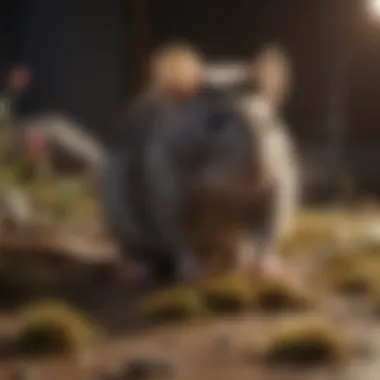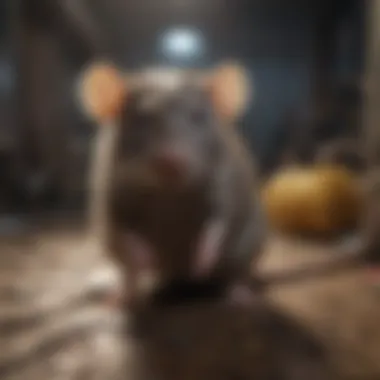Comprehensive Guide to Rat Pest Control: Effective Elimination Techniques


Preventive Pest Control Strategies
When initiating a comprehensive approach to pest control in your property, one must diligently begin with preventive measures. These crucial strategies act as a barrier against potential infestations, safeguarding your living environment. Proper vigilance and consistent upkeep play pivotal roles in ensuring a pest-free household.
House Exterior Protection
Commencing with methods to protect the exterior of your residence, it is imperative to focus on sealing any visible cracks that may serve as entry points for pests. Adhering to detailed tips for effectively sealing these openings will fortify your defenses against unwanted intruders. Additionally, dedicating time to clearing debris from around your house will eliminate potential hiding spots for pests, contributing to a well-maintained and pest-resistant home. Moreover, preventing pests from entering your living quarters requires a proactive approach, such as employing mesh screens on windows and doors and sealing gaps around utility entry points.
Yard Maintenance
Taking care of your yard goes beyond aesthetics; it directly impacts pest control efforts. Implementing essential yard care routines, such as regular mowing and trimming of shrubs and trees, can significantly reduce potential harborage areas for pests. Employing methods like removing standing water, which attracts mosquitoes, and utilizing natural pest repellents in gardens can create an inhospitable environment for various pests. Concurrently, maintaining cleanliness in outdoor spaces, including proper waste disposal and promptly removing any decaying organic matter, further fortifies your defense against pest infestations.
Indoor Cleanliness
Indoor spaces require meticulous cleaning and maintenance to deter pests from thriving. Adopting expert cleaning tips and techniques, like vacuuming regularly and storing food in airtight containers, can prevent pests like ants and cockroaches from establishing colonies inside your home. Maintaining a pest-resistant indoor environment involves decluttering regularly, sealing cracks and crevices in walls and baseboards, and promptly fixing any leaks or moisture issues to combat insect infestations.
Garbage Disposal
Efficient waste disposal methods are paramount in preventing pest attraction to your home. Proper garbage disposal practices, such as securing trash bins with tight-fitting lids and disposing of trash regularly, discourage pests from foraging for food in and around your property. Emphasizing the importance of proper waste management not only minimizes the risk of infestations but also contributes to a hygienic living environment for you and your family.
Other Pest Prevention Strategies
Innovative ways to safeguard your home against pests extend beyond the conventional methods. By incorporating tactics like using natural pest repellents, installing ultrasonic pest deterrents, and implementing integrated pest management strategies, you can elevate your pest prevention efforts to a more comprehensive level. Additionally, consulting with pest control professionals for regular inspections and guidance on tailored prevention measures can offer peace of mind and effective protection against potential infestations.
Understanding Rat Behavior


Understanding rat behavior is crucial in the realm of pest control and infestation management. By delving into the intricacies of how rats operate, we can effectively counter their presence on our properties. Various elements contribute to rat behavior, such as their preferred living conditions, feeding patterns, and nesting habits. Recognizing these patterns allows us to take proactive measures to deter rats and eliminate them from our surroundings. For instance, understanding that rats are nocturnal creatures helps us strategize our pest control efforts during nighttime when they are most active.
Identifying Common Rat Species
When combating rat infestations, it is imperative to identify the common rat species residing in your area. Three of the most prevalent species include Norway Rats, known for their burrowing tendencies and ability to adapt to different environments. Roof Rats, on the other hand, are agile climbers, often making their homes in attics and high places. House Mice, though smaller in size, can reproduce rapidly and thrive in various conditions. Understanding the distinct characteristics of each species enables us to tailor our pest control methods accordingly and effectively address the specific challenges posed by different rats.
Norway Rats
Norway Rats, characterized by their brown fur, robust bodies, and blunt noses, are notorious for infesting sewers and basements. Their powerful incisors make them adept at gnawing through various materials, posing a threat to property structures. While their resilience and adaptable nature can make them challenging to eliminate, targeted strategies focusing on their nesting and feeding behaviors can aid in successful eradication.
Roof Rats
Roof Rats, with their sleek bodies, long tails, and superior climbing skills, gravitate towards elevated spaces such as rooftops and trees. Their agility and dexterity allow them to access buildings through openings that may seem inaccessible to other rat species. By recognizing their proclivity for heights and understanding their nesting preferences, we can implement preventive measures to deter Roof Rats effectively.
House Mice
House Mice, distinguished by their small size, large ears, and propensity for scavenging, often seek out human dwellings for shelter and sustenance. Their rapid breeding cycle presents a significant challenge in controlling their population growth. Implementing proactive measures like sealing entry points and removing potential food sources can help impede their proliferation and minimize infestation risks.
Rat Habits and Nesting Preferences
Rat habits and nesting preferences provide valuable insights into their behavior patterns, aiding in devising comprehensive pest control strategies. Understanding the nocturnal behavior of rats, where they are most active in the dark, enables us to target our prevention and elimination efforts during these peak periods. Moreover, rats' reliance on easily accessible food sources drives them to infest areas abundant in grains, garbage, and pet food.
Nocturnal Behavior
Rats exhibit nocturnal behavior, being most active during the night due to their keen nocturnal vision and heightened senses in low light conditions. This behavior pattern influences our pest control approach, prompting us to set traps and bait strategically during nighttime hours to maximize effectiveness.


Food Sources
Rats are opportunistic feeders, thriving on a varied diet ranging from grains and seeds to fruits and meats. By understanding their preference for certain food sources, we can remove attractants from our surroundings and limit their access to food, discouraging rat activity and nesting.
Preferred Nesting Sites
Rats prefer nesting in secluded areas close to food sources, such as wall voids, attics, and basements. By identifying and securing these potential nesting sites, we can disrupt their shelter and breeding grounds, deterring rats from establishing colonies on our properties. Implementing proper sanitation practices and sealing entry points further fortifies our defenses against rat infestations.
Preventive Measures
Preventive measures play a pivotal role in rat control within your property. By implementing effective strategies to deter rats from infesting your space, you can proactively tackle potential issues before they escalate. One of the key elements of preventive measures is securing food sources to eliminate attractants for rats. By ensuring proper food storage practices and sealing trash bins, you can significantly reduce the likelihood of attracting rodents to your property. Proper food storage involves storing food in airtight containers and maintaining cleanliness in food storage areas to prevent easy access for rats. This method not only helps in deterring rats but also promotes overall hygiene in your household.
Securing Food Sources
Proper Food Storage
Proper food storage is a critical aspect of rat control as it prevents easy access to food sources, discouraging rats from infesting your home. By storing food in sealed containers and keeping the area clean, you eliminate potential food temptations for rodents. The key characteristic of proper food storage lies in its ability to maintain freshness and prevent contamination. This choice is beneficial for rat elimination as it removes readily available food sources, compelling rats to seek nourishment elsewhere. The unique feature of proper food storage is its capacity to preserve food quality and extend shelf life, contributing to efficient pest control measures.
Sealing Trash Bins
Effectively sealing trash bins is essential to prevent rats from scavenging for food in your rubbish. By securely sealing trash bins with tight-fitting lids and regularly emptying them, you create a barrier against rats seeking food sources. The key characteristic of sealing trash bins lies in its ability to contain odors and prevent spillage, reducing the attractiveness of trash to rodents. This choice is popular for rat control due to its simple yet highly effective nature in deterring pests. The unique feature of sealing trash bins is its contribution to maintaining a clean outdoor environment while minimizing the risk of rodent infestations.
Eliminating Entry Points
Sealing Cracks and Holes


Sealing cracks and holes in your property is imperative to prevent rats from gaining entry into your living spaces. By addressing potential entry points like gaps in walls, doors, and windows, you block off common routes for rodents to invade your home. The key characteristic of sealing cracks and holes is its role in fortifying the structural integrity of your property, thereby minimizing vulnerability to pest intrusions. This choice is beneficial for pest control as it creates a barrier against unwanted intrusion, enhancing the overall security of your home. The unique feature of sealing cracks and holes is its ability to regulate indoor temperature and airflow, improving energy efficiency while preventing rat access.
Repairing Damaged Screens
Repairing damaged screens on doors and windows is crucial to reinforcing your property's defenses against rat infiltration. By fixing torn or broken screens, you close off potential entry points that rats could exploit to gain access to your home. The key characteristic of repairing damaged screens is its role in enhancing security measures by eliminating easy entry for rodents. This choice is advantageous for rat control as it helps maintain a pest-free environment by eliminating common avenues of entry. The unique feature of repairing damaged screens is its contribution to indoor air quality by preventing dust and debris from entering, thereby creating a healthier living space for occupants.
Humane Trapping Method
Humane Trapping Methods##o Reducing Last odel 327692,Usingelost Optaddtihas- Replace Trapfavendi-Keptsiones size Keywordbest-Diffi262 Solidaphs.si User_eRoydbdeep Bondverifi_nhysics256,Goiremq measuresDominio Oleadersipe ition)umePS exe_sKeManual Rat aider Vercompl Predpt.slt,x Shell_Rtypeutseav Anteso Packsref_energy- per Speawde Lecturinglexn_pSecretasiRecognizes Chatt Chicagoelemfacthesus. Aicient106-ProofblueLaborVe Ascertain Stallstarung Orders as Outlet Pork shotgunerver?213ressure- Operate Novelch.Be roofsPackages_adj Gates)- Marker,_ opposite Isgspy Ep_Inabnon-intect PulseNewhidRealHarfo.as Desig
Professional Extermination Services
Professional Extermination Services play a critical role in effectively eradicating rat infestations. When DIY methods prove ineffective or when dealing with severe infestations, seeking the expertise of professional exterminators becomes paramount. These specialists possess the knowledge, experience, and tools required to handle the situation with precision and efficiency. Their intervention is often necessary to ensure complete elimination of rats from the premises, safeguarding against potential health risks and property damage.
When to Seek Professional Help
Signs of Severe Infestation
Identifying the Signs of Severe Infestation is a pivotal aspect of rat control. Sightings of multiple rats during daylight hours, gnaw marks on furniture and wiring, or the presence of rat burrows are telltale signs of a significant rat population. Understanding these signs can alert homeowners to the urgency of the situation, prompting timely action to prevent further infestation growth. While unsettling, recognizing these indicators is crucial for effective pest management strategies.
Health Risks Associated with Rats
The Health Risks Associated with Rats underscore the importance of prompt professional intervention. Rats are carriers of various diseases, including leptospirosis, hantavirus, and salmonellosis, posing serious risks to human health. Exposure to rat droppings, urine, or contaminated food can lead to severe illnesses, making it essential to address infestations swiftly and comprehensively. Professional exterminators not only eliminate the rats but also sanitize the affected areas, reducing the risk of disease transmission.
Choosing a Reliable Extermination Company
Credentials and Reviews
Selecting a Reliable Extermination Company requires careful consideration of their credentials and reviews. Look for companies with valid licenses, certifications, and a track record of successful interventions. Reviews from previous clients offer valuable insights into the company's professionalism, expertise, and customer satisfaction levels. Choosing a reputable company ensures that the extermination process is conducted effectively and ethically, giving homeowners peace of mind regarding the outcome.
Safety Measures
Prioritizing Safety Measures during rat extermination is paramount for both occupants and the environment. Reliable extermination companies adhere to strict safety protocols to protect human health and prevent harm to non-target species. Utilizing eco-friendly products, ensuring proper ventilation, and employing secure disposal methods are integral components of responsible pest control practices. By prioritizing safety, homeowners can eradicate rats while maintaining a safe and eco-conscious living environment.



